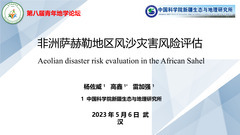报告详情
Aeolian disaster risk evaluation in the Africa Sahel
编号:2416
访问权限:私有
更新:2023-04-11 19:12:31 浏览:600次
口头报告
摘要
The Sahel is suffering from severe aeolian disaster, which seriously affects the survival and development of local residents. This study compares the applicability of different evaluation methods to the aeolian disaster risk evaluation in the Sahel and the optimal evaluation model is proposed. Four subsystems of aeolian disaster risk are established, and the spatial distributions of hazard, sensitivity, vulnerability and restorability are obtained respectively. The spatiotemporal changes of aeolian disaster risk in the Sahel from 2000 to 2020 are analysed. The findings show that the variable fuzzy recognition (VFR) based on natural disaster risk index model is the most suitable method for aeolian disaster risk evaluation in the Sahel, with an overall accuracy of 89.72%. The middle of the Sahel located in the desert-grassland transition zone is undergoing a sensitive climate and close proximity to sand source, with high hazard, sensitivity and vulnerability, leading to very high risk of aeolian disaster. From 2000 to 2020, very low and very high levels of aeolian disaster risk in the Sahel were decreasing, low and high levels were increasing, and the change of moderate risk level remained relatively stable. Low, moderate, and high risk are more sensitive to climate change and human activities, undergoing greater change intensity. Human activities are the main factors that increase (Northern Sahel) and reduce (Southern Sahel) aeolian disaster risk. The study is helpful to identify aeolian disaster risk levels and the changes in the Sahel, providing reference for the local government to prevent and control aeolian disaster.
关键词
Aeolian disaster; Variable fuzzy recognition; Natural disaster risk index model; Spatiotemporal changes; Sahel
报告人

杨佐威
中国科学院新疆生态与地理研究所稿件作者
全部评论
重要日期
-
会议日期
05月05日
2023
至05月08日
2023
-
03月31日 2023
初稿截稿日期
-
05月25日 2023
注册截止日期
主办单位
青年地学论坛理事会
中国科学院青年创新促进会地学分会
中国科学院青年创新促进会地学分会
承办单位
武汉大学
中国科学院精密测量科学与技术创新研究院
中国地质大学(武汉)
中国科学院精密测量科学与技术创新研究院
中国地质大学(武汉)



发表评论